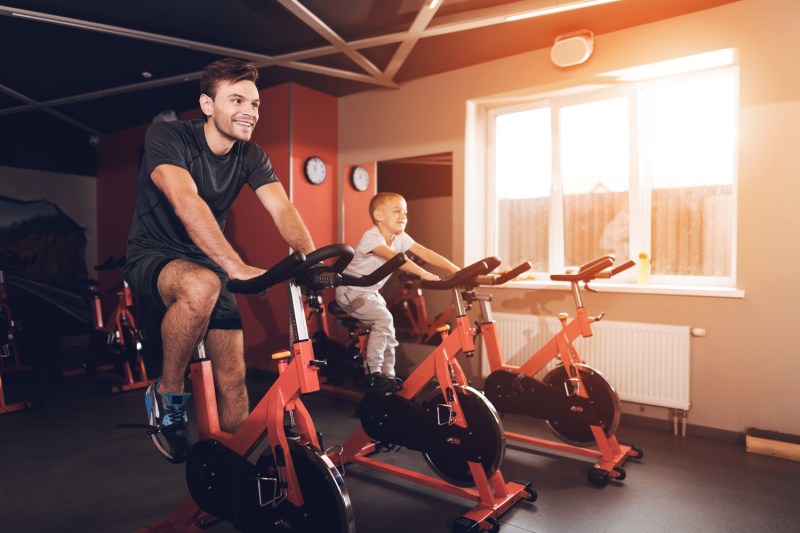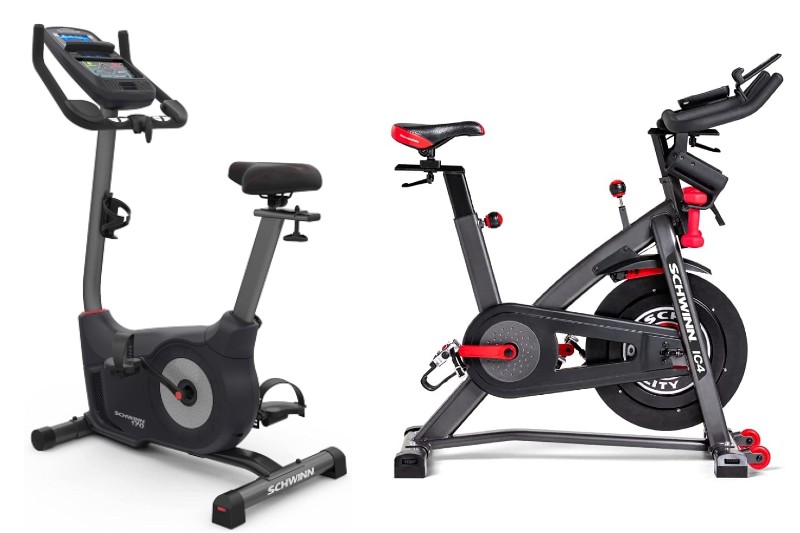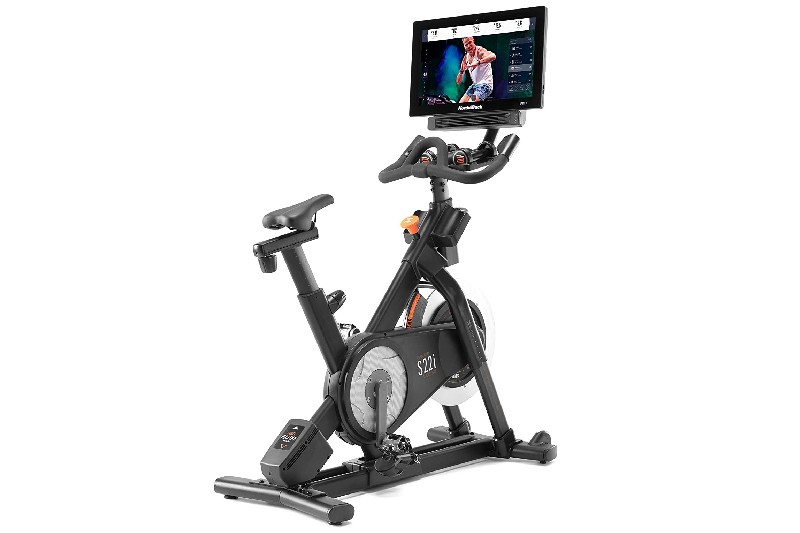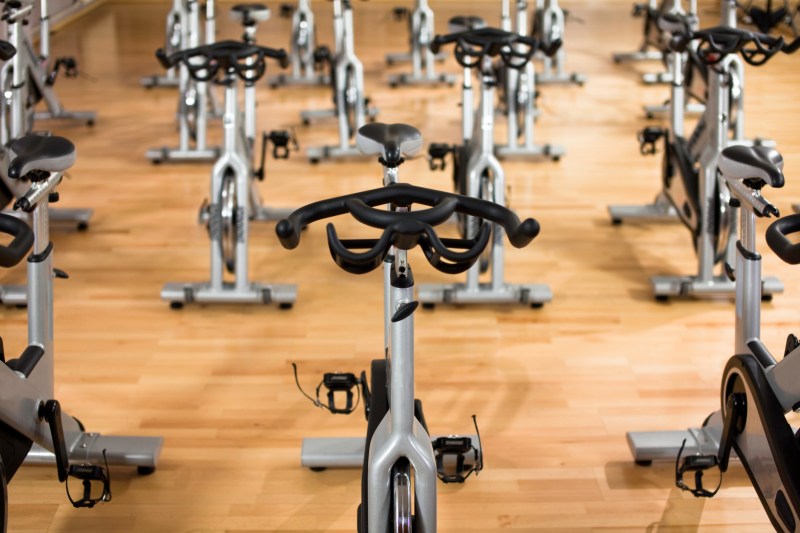
Exercise bikes supply an excellent form of low-impact cardio, and they can provide the body with many benefits when enjoyed regularly. Cycling is also a great choice for many because there is minimal stress put on the joints, and cycling indoors can keep you safe from traffic and busy streets. Now, we just have to consider the difference between a stationary bike vs. spin bike when it comes to what piece of equipment is best for you to get started with.
Both types of exercise bikes provide the same general benefits, though there are pros and cons to each. Whether you’re looking to buy an exercise bike for your home gym or just want to know, “Is a spin bike the same as a stationary bike?” — keep reading to see how stationary bikes and spin bikes compare.

3 benefits of cycling
1. Strengthens the lower body
Whether you are using a stationary bike or a spin bike, your glutes, quads, hamstrings, and calves are all putting in work to support the movement. If you are consistent with cycling and utilize progressive overload, you will likely see a development in the muscles of your lower body.
2. Supports weight loss
Cycling is a great form of cardio that will be sure to have you burning some calories. As long as you make sure it is a challenging ride, you can use a spin bike or exercise bike for weight loss to burn enough calories to lose a couple of pounds per week when combined with a healthy, nourishing diet.
3. Improves cardiovascular fitness
When you first start using a stationary bike or a spin bike, you may find yourself getting out of breath and tiring quickly. However, if you stick with a regular workout schedule and go a little further or a little faster each time, then your heart and lungs will adapt, and your blood circulation can improve as well!

Primary differences between stationary bikes and spin bikes
Stationary bikes refer to the traditional upright exercise bikes you’ve likely seen at a gym. They have a console and usually have pre-loaded programs. You can adjust the resistance by selecting the level, and you can pedal faster or slower to adjust the difficulty of the workout as well. There are also recumbent stationary bikes, which have the seat reclined back. Stationary bikes usually use direct contact resistance.
Spin bikes, also called indoor cycles, may not have a console, but they have an exposed flywheel, which is often significantly heavier than the flywheel on a stationary bike. Most indoor cycles use friction resistance or magnetic resistance. Friction resistance relies on felt or rubber pads pressing on the flywheel to resist its motion when you pedal, so the bikes have a dial or knob to increase or decrease resistance. Magnetic resistance has discrete levels of resistance, like stationary bikes.
Stationary bikes vs. spin bikes: Workout intensity
Generally speaking, you can get a more intense workout on a spin bike than a stationary bike. Spin bikes require greater muscle activation, including some upper body and core, whereas the workout on a stationary bike is really just isolated to the legs. They also have a heavier flywheel. You can also stand on a spin bike for climbs and aggressively hard efforts, whereas you should not stand on a stationary bike.
The nature of the workouts also tends to be different because most spin classes and indoor cycling workouts are HIIT style workouts or designed to be high-intensity vigorous efforts to improve cardiovascular fitness. Most stationary bike workouts are designed to be more moderate aerobic efforts that improve markers of health. Of course, you can do an easy-pedaling workout on a spin bike and push yourself to the max on a stationary bike, but the general primary purposes are somewhat inherently different.
Stationary bikes vs. spin bikes: Resistance
As mentioned, stationary bikes and spin bikes may use a variety of mechanisms to generate friction. Friction resistance spin bikes use felt pads and ultimately have the highest maximal ceiling of resistance, which would be when the felt pad is fully against the flywheel in a full stop. They also have an infinite number of levels because the adjustability is continuous rather than discrete.
However, there are downsides to friction resistance spin bikes. The felt pads can wear out over time and may need to be replaced. It’s also not possible to know exactly what “level” you’re on, so it’s difficult to follow instructor-led workouts like Peloton classes or compare one workout to the next using difficulty. In other words, you can’t easily quantify your effort.
Spin bikes with magnetic resistance are more precise. They also run smoother and quieter, but you’re limited to the levels they have on the bike. You may find the easiest level too difficult, the hardest level not challenging enough, or the gradations between levels too great to dial into the exact effort level you’d like.
The direct contact resistance on stationary bikes is similar to friction resistance and can wear out. Moreover, the bikes don’t allow you to turn a dial to micro-adjust the resistance. Instead, there are numbered levels you’re locked into choosing.
Stationary bikes vs. spin bikes: Muscles worked
Both types of exercise bikes predominantly work the quads, hamstrings, and calves, with the glutes to a lesser extent. Spin bikes also strengthen the shoulders, core, and back to some degree. Standing on a spin bike turns it into a total-body exercise. Note that recumbent bikes offer the least core activation since your torso is supported by the seat.
Stationary bikes vs. spin bikes: Adjustability
Most exercise bikes allow for seat height adjustments, handlebar height adjustments, and resistance adjustments. Spin bikes often allow additional adjustability features like fore/aft adjustments of the seat and handlebars and a greater number of resistance levels.
Stationary bikes vs. spin bikes: Calories burned
Regardless of the type of exercise bike you use, the number of calories you burn riding an exercise bike will depend on the intensity and duration of your workout. In general, the energy expenditure is higher on a spin bike or indoor cycle than on a stationary bike, so you’ll burn more calories on a spin bike workout compared to a similar workout on a stationary bike.
Spin bikes require more muscle activation, have a heavier flywheel, and allow for a greater ceiling of intensity. Again, it’s also important to note that most spin bike workouts are inherently designed to be more vigorous than an aerobic stationary bike workout.

Stationary bikes vs. spin bikes: Console
Though there are an increasing number of popular indoor cycles with smart technology and integrated consoles, many spin bikes do not come with a console. On the other hand, stationary bikes have an embedded console. The console typically keeps track of metrics like workout time, level, calories burned, distance, heart rate, etc. There may be pre-programmed workout programs as well.
Fancier indoor cycles like the MYX II Plus, Peloton, Schwinn IC4, and Echelon bikes have touch screens and app connectivity. They offer all the benefits of a stationary bike console with additional perks like video streaming. Plus, you can stream interactive classes to boost your motivation.
Stationary bikes vs. spin bikes: Similarity to outdoor cycling
Spin bikes or indoor cycles are designed to more closely mimic the riding position of an outdoor bike, such that you’re leaning forward more. Stationary bikes are more upright and have a less aggressive riding position.
The pedal stroke is also supposed to feel more realistic on a spin bike versus a stationary bike. Indoor cycles with chain-drive mechanisms instead of belt drives will feel even more similar to an outdoor bicycle.
Stationary bikes vs. spin bikes: Cost
There’s quite a range of prices for both stationary bikes and spin bikes, depending on the quality of construction, type of resistance, technology, and bells and whistles. However, in general, stationary bikes for home use are less expensive than spin bikes. You can find affordable indoor cycles and spin bikes, though, as long as you’re willing to get models without a touchscreen console.
Stationary bikes vs. spin bikes: Final pros and cons
You can be well served with a stationary bike or an indoor cycle and can likely get a decent cardio workout on either type of exercise bike. However, if you’re looking to really boost your fitness and get a more intense workout, you’ll probably do better with a spin bike. On the other hand, if you’re looking for a more beginner-friendly, basic piece of exercise equipment for aerobic exercise, a stationary bike may save you some money and be a little easier to use.

Sample indoor bike exercise plans to kickstart weight loss
No matter if you choose a standard stationary bike or a spin bike for your weight loss program, it’s vital to follow a plan to make sure you get the maximum impact from your exercise and avoid any injuries.
If you’re just starting out, you don’t want to jump right into the highest-intensity workout possible, it’s better to start slowly with a 30-minute interval workout and build up to the more intense workouts.
- Start with a 5-10 minute warmup.
- Then, pick up your pace, and go in intervals of high (1-2 minutes) and medium intensity (5 minutes)
- Cool down at low intensity for at least 5 minutes.
Once you have done those beginner workouts for a few days or so, you can start working out to lose weight by increasing the intensity of your intervals, switching from 3-5 minutes of medium intensity and 1-3 minutes of high intensity for around 30 minutes, followed by a 10-minute cooldown. As with any workout program, you should talk to your doctor before starting out.



